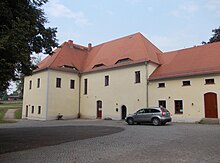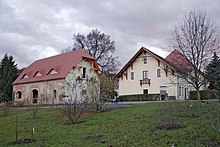Marienthal Monastery (Sornzig)
The Monastery Marienthal was a Cistercian monastery in what is now the district Sornzig the city Mügeln in Nordsachsen in Saxony .
The monastery is located on the Hasenbach, a tributary of the Döllnitz near Mügeln in the center of the orchard in a hilly landscape. Sornzig is roughly halfway between Leipzig and Dresden . Larger places nearby are Leisnig and Döbeln .
architecture
In addition to the sister house, the monastery wall that surrounds the entire site, the monastery barn and the monastery garden with fish pond and the historic monastery mill have been preserved from the old monastery complex.
history
Founding of a monastery
Around 1150 Sifridus de Mogelin (Siegfried I von Mügeln) founded a noble farm in Sornzig . His ancestors received the area around the Festenberg as a royal gift in the 11th century, probably to act as bailiffs of the Meissen bishopric . The nunnery Marienthal of the Cistercian order in Sornzig was in 1241 by Siegfried III. Donated by Mügeln. A Burgwart chapel on the Festenberg had been owned by the monastery since 1218. In 1243, Bishop Konrad von Meißen testified that Siegfried von Mügeln had placed the parish church of Sornzig and the castle chapel at Mügeln under the monastery. Through donations to the monastery, the surrounding villages came into possession of the monastery, which was administered by the monastery office in Sornzig . The Cistercian nuns introduced fruit growing in the monastery.
Time until the Reformation in 1539
In 1252, Margrave Heinrich the Illustrious (1215 / 16–1288) took the Marienthal Monastery under his protection. He often appeared as a patron of the monastery. The monastery was largely destroyed by fire in 1278. The construction of the destroyed buildings was financed through various indulgences , including by Bishop Friedrich von Merseburg .
The period from the Reformation in 1539 to the abdication of the last Bishop of Meissen in 1581
In the age of the Reformation , the strict discipline of the Cistercian women began to wane. The flight of the nun Katharina von Bora from the nearby Nimbschen monastery at Easter 1523 was followed by six nuns from the Sornzig monastery. Her escape helper was then beheaded. In the course of the introduction of the Reformation, the Marienthal Monastery was secularized around 1539/1540 . The monastery was closed and the property confiscated by the state was made available to the Princely School of St. Afra in Meissen . The area of the monastery was administered between 1540 and 1570 as part of the electoral education authority of Meissen . Then it came to the Meißner Bishop Johann IX in exchange for the Mühlberg office . from Haugwitz .
The Sornzig Monastery under the administration of the Wurzen Abbey Office 1581–1818
On October 20, 1581 the last bishop Johann IX thanked . von Haugwitz and converted to Protestantism. He lived in Mügeln until his death in 1595 and received the Ruhethal Castle , built around 1150, to which he gave this name, as well as the former Marienthal Monastery in Sornzig, as an annuity .
The Sornzig monastery office , which had been in the possession of the bishop since 1570, was placed under the administration of the Wurzen collegiate monastery in 1584 . It was thus fully in the since 1547 Albertine Electorate incorporated, although there are still as part of the pen Office Wurzen was managed until 1818 by a specially created "Electoral Saxon pin Government" on behalf of the Dresden court.
In 1608, the Sornzig monastery was leased to Georg von Schleinitz for 12 years . Between 1666 and 1761 the former Sornzig monastery was a manor owned by the von Burkersroda family . From 1763, ownership of the monastery property was distributed to the officials. In 1797, the three new towns of Lichteneichen, Neubaderitz and Neusornzig were founded on the abandoned Sornziger Klosterland.
The former Sornzig monastery from 1818 to modern times
After the dissolution of the Wettin monastery government and the dissolution of the Wurzen monastery office in 1818, the Mügeln and Sornzig office became a sovereign office in the Leipzig district of the Kingdom of Saxony . It existed until 1856 and was then replaced by the Mügeln and Oschatz court offices .
The monastery grounds were bought in 1892 by the Leipzig city planner Ludolf Colditz . He restored the buildings and introduced modern fruit orchards in Sornzig. After the Second World War , the Colditz family was expropriated in 1946. The fruit growing was carried on as a state enterprise as "Volksgut Sornzig" until the political change in 1989. After that, the monastery was bought back by the Colditz family and the building was reconstructed inside and outside in accordance with a listed building. In 1996 the foundation “Dr. Ludolf Colditz - Marienthal Monastery ”, which is committed to maintaining and using the facility. Since 2003 the monastery has been a European meeting and educational center. The fruit growing company has been operated by the Sachsenobst company since the political change .
Web links
- Website about the Sornzig Monastery at the Dr. Ludolf Colditz - Marienthal Abbey
- The Sornzig Monastery on the website of the Leipzig Church District
Coordinates: 51 ° 12 '46 " N , 13 ° 1' 0.4" E





